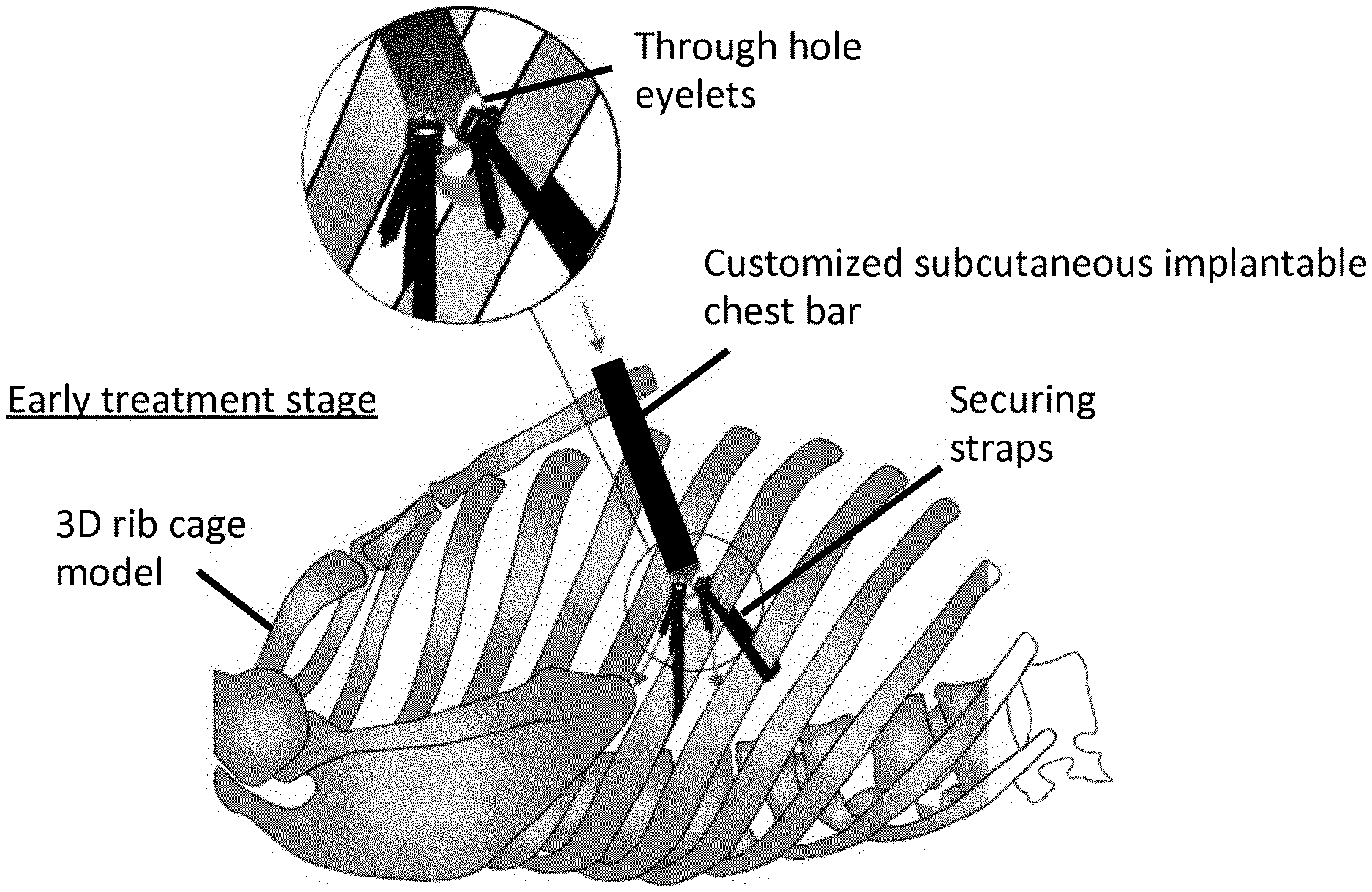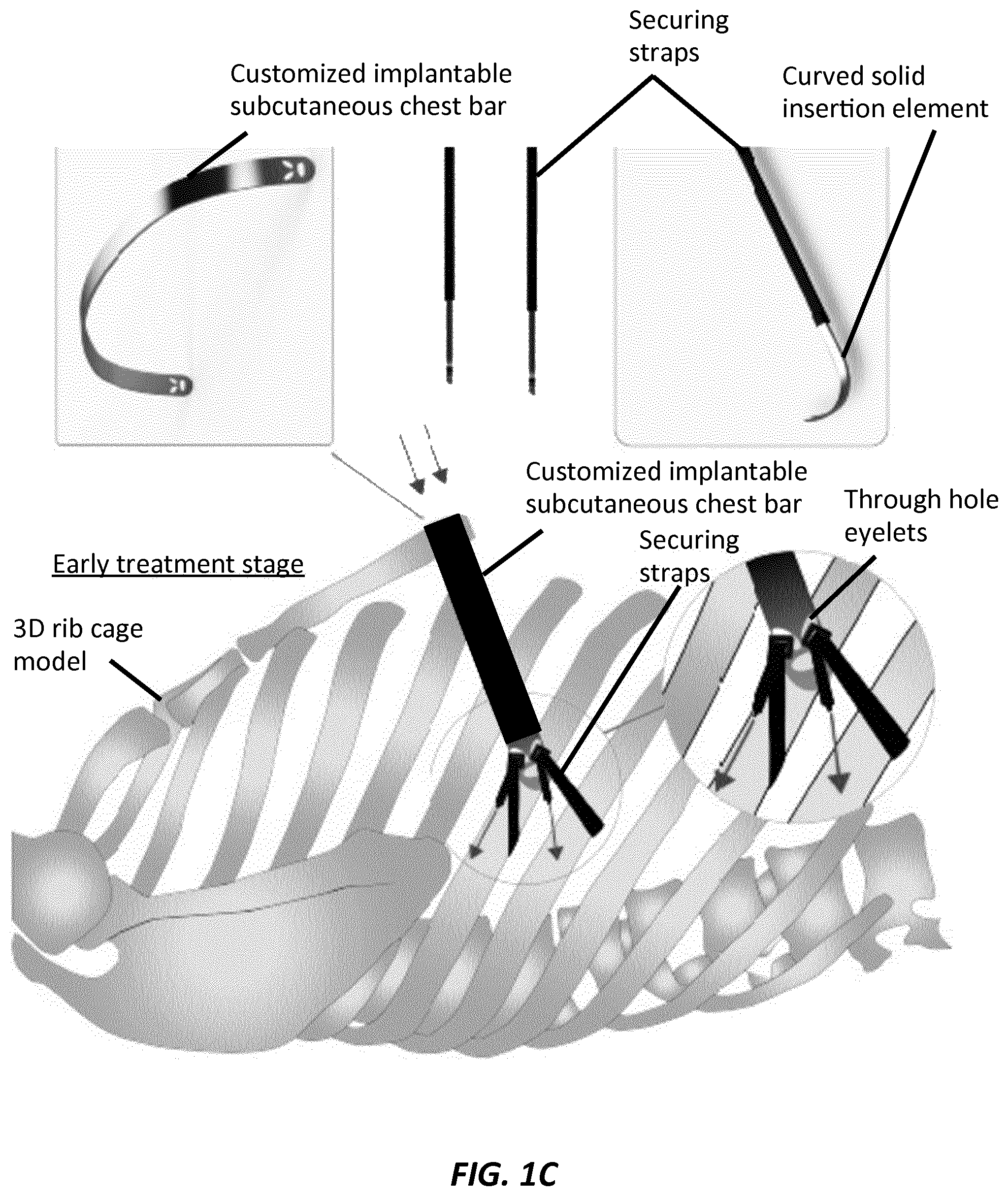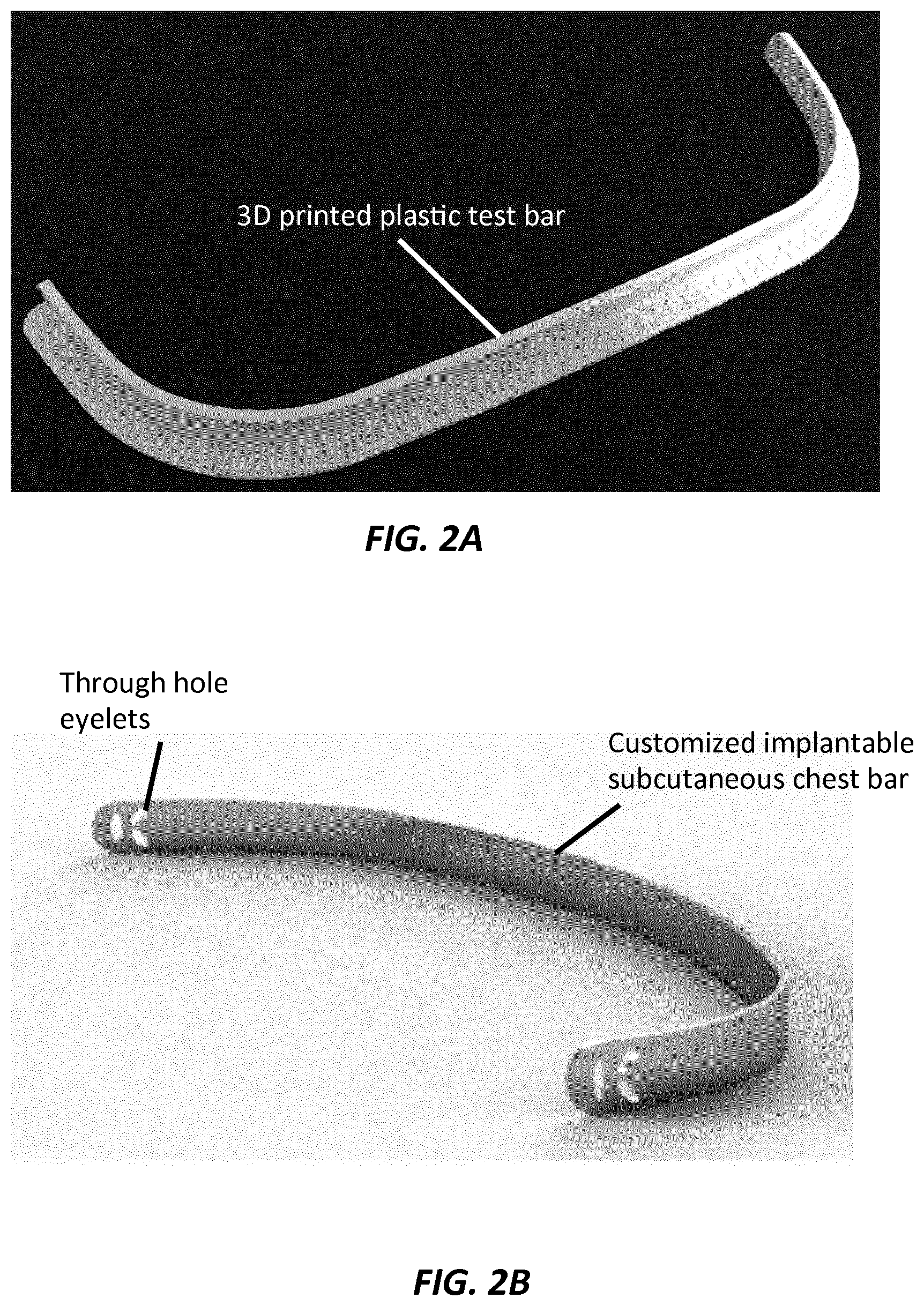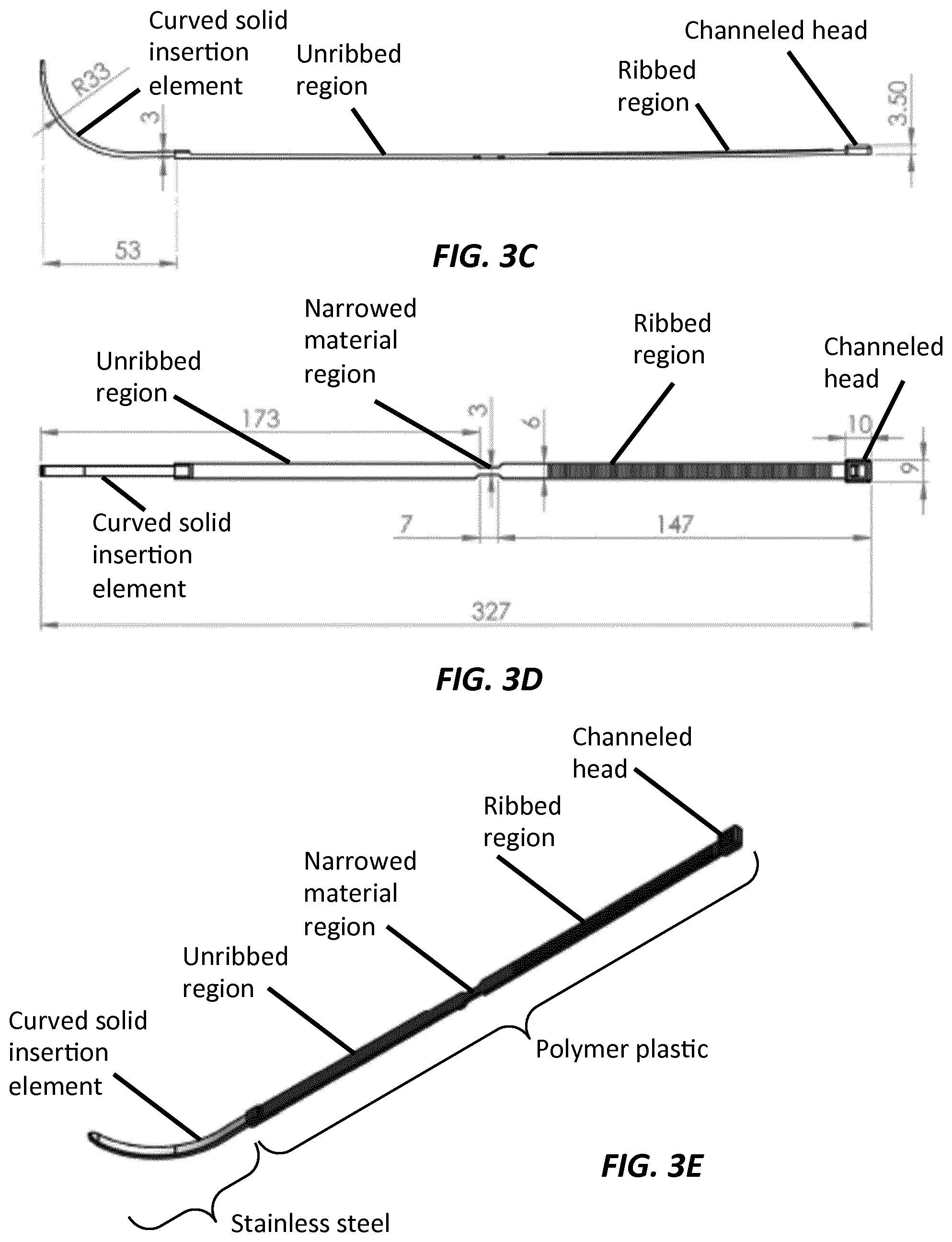Zip to the rib sternal pull-back system and method for pectus carinatum treatment
Martinez-Ferro , et al. September 29, 2
U.S. patent number 10,786,294 [Application Number 16/084,731] was granted by the patent office on 2020-09-29 for zip to the rib sternal pull-back system and method for pectus carinatum treatment. This patent grant is currently assigned to PAMPAMED SRL. The grantee listed for this patent is PAMPAMED SRL. Invention is credited to Gaston Bellia-Munzon, Marcelo Hernan Martinez-Ferro.






| United States Patent | 10,786,294 |
| Martinez-Ferro , et al. | September 29, 2020 |
Zip to the rib sternal pull-back system and method for pectus carinatum treatment
Abstract
A pectus carinatum sternal pull-back device is provided that includes an implantable subcutaneous chest bar, where a size, a curve, a length and a width of the implantable later chest bar are customized according to predetermined sternum and rib cage dimensions of a pectus carinatum patient, where the customized implantable subcutaneous chest bar includes through holes at the ends of the customized implantable subcutaneous chest bar, and at least a pair of securing straps, where the securing strap includes a channeled head element at a first securing strap end, a semi-ribbed strap, and a curved solid insertion element at a second end, where the channeled head element includes a barb for receiving and locking the semi-ribbed strap, where the securing strap is configured for insertion through the through holes of the implantable subcutaneous chest bar.
| Inventors: | Martinez-Ferro; Marcelo Hernan (Buenos Aires, AR), Bellia-Munzon; Gaston (Buenos Aires, AR) | ||||||||||
|---|---|---|---|---|---|---|---|---|---|---|---|
| Applicant: |
|
||||||||||
| Assignee: | PAMPAMED SRL (Buenos Aires,
AR) |
||||||||||
| Family ID: | 1000005080667 | ||||||||||
| Appl. No.: | 16/084,731 | ||||||||||
| Filed: | March 10, 2017 | ||||||||||
| PCT Filed: | March 10, 2017 | ||||||||||
| PCT No.: | PCT/EP2017/055718 | ||||||||||
| 371(c)(1),(2),(4) Date: | September 13, 2018 | ||||||||||
| PCT Pub. No.: | WO2017/157802 | ||||||||||
| PCT Pub. Date: | September 21, 2017 |
Prior Publication Data
| Document Identifier | Publication Date | |
|---|---|---|
| US 20190069938 A1 | Mar 7, 2019 | |
Related U.S. Patent Documents
| Application Number | Filing Date | Patent Number | Issue Date | ||
|---|---|---|---|---|---|
| 62308965 | Mar 16, 2016 | ||||
| Current U.S. Class: | 1/1 |
| Current CPC Class: | A61B 17/88 (20130101); A61B 17/823 (20130101); A61B 17/8076 (20130101); A61B 17/842 (20130101); A61B 2017/00526 (20130101) |
| Current International Class: | A61B 17/82 (20060101); A61B 17/88 (20060101); A61B 17/84 (20060101); A61B 17/80 (20060101); A61B 17/00 (20060101) |
References Cited [Referenced By]
U.S. Patent Documents
| 4730615 | March 1988 | Sutherland |
| 6024759 | February 2000 | Nuss |
| 7156847 | January 2007 | Abramson |
| 7603192 | October 2009 | Martin |
| 2004/0117016 | June 2004 | Abramson |
| 2014/0257291 | September 2014 | Houff |
| 0238219 | Sep 1987 | EP | |||
| 2166292 | May 2001 | RU | |||
| WO-2015003061 | Jan 2015 | WO | |||
Other References
|
RU2166292 Machine Translation Retrieved from EPO website on Nov. 13, 2019. cited by examiner . Abramson et al., "A 5-year experience with a minimally invasive technique for pectus carinatum repair" Journal of Pediatric Surgery (2009) 44, 118-124. cited by applicant. |
Primary Examiner: Waggle, Jr.; Larry E
Attorney, Agent or Firm: Lumen Patent Firm
Parent Case Text
CROSS-REFERENCE TO RELATED APPLICATIONS
This application is a 371 of PCT application PCT/EP2017/055718 filed on Mar. 10, 2017. PCT application PCT/EP2017/055718 claims the benefit of U.S. Provisional application 62/308,965 filed on Mar. 16, 2016.
Claims
What is claimed:
1. A pectus carinatum sternal pull-back device, comprising: a) an implantable subcutaneous chest bar, wherein a size, a curve, a length and a width of said implantable subcutaneous chest bar are customized according to predetermined sternum and rib cage dimensions of a pectus carinatum patient, wherein said customized implantable subcutaneous chest bar comprises at least a pair of through holes at each end of said customized implantable subcutaneous chest bar; and b) securing straps for each of the through holes at each of the ends of said customized implantable subcutaneous chest bar, wherein each of said securing straps as a pair at each end is capable of securing said customized implantable subcutaneous chest bar in a splayed pattern to each securing strap securing individual ribs at each end of said customized implantable subcutaneous chest bar, wherein each of said securing straps comprises a polymeric plastic channeled head element at a first securing strap end, a polymeric plastic semi-ribbed strap, and a stainless steel curved solid insertion element at a second end, wherein said channeled head element comprises a barb for receiving and locking said semi-ribbed strap, wherein each of said securing straps is configured for insertion through said through holes of said implantable subcutaneous chest bar.
2. The pectus carinatum sternal pull-back device of claim 1, wherein said implantable subcutaneous chest bar comprises material selected from the group consisting of titanium, and surgical steel.
3. The pectus carinatum sternal pull-back device of claim 1, wherein said predetermined sternum and rib cage dimensions comprise a 3D digital image of said sternum and rib cage dimensions from a patient according to output from a CT scan of said patient.
4. The pectus carinatum sternal pull-back device of claim 3, wherein a 3D plastic printed test bar is configured from said 3D digital image of said sternum and rib cage dimensions.
5. The pectus carinatum sternal pull-back device of claim 1, wherein said at least pair of through holes comprise oval through holes or elongated through holes, wherein said through holes comprise a pattern of said through holes.
6. The pectus carinatum sternal pull-back device of claim 1, wherein said semi-ribbed strap comprises a narrowed material region that is proximal to a middle of said semi-ribbed strap, wherein said semi-ribbed strap is ribbed along a span from proximal to said channeled head element to proximal to said narrowed material region and is un-ribbed from proximal to said narrowed material region to said curved solid insertion element.
7. A method of pectus carinatum sternal pull-back, comprising a) marking bar entry and exit sites on a patient rib cage; b) selecting intercostal spaces on said patient rib cage; c) making bilateral skin incisions at said selected intercostal spaces; d) creating a submuscular tunnel from an anterior aspect of said bilateral incisions to a highest point of a pectus carinatum sternal defect; e) advancing a subcutaneous dissector into said submuscular tunnel from a proximal side of said rib cage to a distal side of said rib cage; f) pulling a customized bar, using an umbilical tape, through said submuscular tunnel to a predetermined position on said rib cage; g) placing securing straps around selected ribs of said rib cage as a pair in a splayed pattern direction relative to said customized bar, wherein said selected ribs are located on each side of said rib cage, wherein said securing straps are passed through eyelets of said customized bar, and wherein each of said securing straps comprises a polymeric plastic channeled head element at a first securing strap end, a polymeric plastic semi-ribbed strap, and a stainless steel curved solid insertion element at a second end; h) applying a pressure to an anterior chest wall while tightening said securing straps at each end for correcting said pectus carinatum sternal defect; and i) closing said bilateral skin incisions.
Description
FIELD OF THE INVENTION
This invention relates to pectus carinatum treatment. More particularly, the invention relates to minimally invasive surgery for pectus carinatum.
BACKGROUND OF THE INVENTION
Pectus carinatum is a deformity of the chest characterized by a protrusion of the sternum and ribs.
Currently, surgically implanted orthotic braces are used for some cases of pectus carinatum. With the cases of children, teenagers, and young adults that wish to avoid surgery, a chest-wall brace has been used that is configured to apply direct pressure on the protruding area of the chest, where the brace is essential for the success of this treatment approach. In one instance, the brace includes front and back compression plates that are anchored to aluminum bars. These bars are bound together by a tightening mechanism, which varies from brace to brace. This device is easily hidden under clothing and must be worn from 14 to 24 hours a day. The wearing time varies with each brace manufacturer and the managing physicians protocol, which could be based on the severity of the carinatum deformity and if it is symmetric or asymmetric.
In some instances, the brace may be worn on the skin or it may be worn over a body `sock` or sleeve specifically designed to be worn under braces.
For patients with severe pectus carinatum, surgery may be necessary. Minimally invasive surgery for pectus carinatum (PC) has shown to be an effective surgical procedure, although with current approaches the mayor drawback is implant fixation.
What is needed is a surgical technique and apparatus that uses dedicated custom-made implants and an efficient reduced complexity fixation system.
SUMMARY OF THE INVENTION
To address the needs in the art, a pectus carinatum sternal pull-back device is provided that includes an implantable subcutaneous chest bar, where a size, a curve, a length and a width of the implantable subcutaneous chest bar are customized according to predetermined sternum and rib cage dimensions of a pectus carinatum patient, where the customized implantable subcutaneous chest bar includes through holes at the ends of the customized implantable subcutaneous chest bar, and at least a pair of securing straps, where the securing strap includes a channeled head element at a first securing strap end, a semi-ribbed strap, and a curved solid insertion element at a second end, where the channeled head element includes a barb for receiving and locking the semi-ribbed strap, where the securing strap is configured for insertion through the through holes of the implantable subcutaneous chest bar.
According to one aspect of the invention, the implantable subcutaneous chest bar includes material selected such as titanium, or surgical steel.
In another aspect of the invention, the predetermined sternum and rib cage dimensions include a 3D digital image of the sternum and rib cage dimensions from a patient according to output from a CT scan of the patient. Here, a 3D plastic printed test bar is configured from the 3D digital image of the sternum and rib cage dimensions for test fitting the implantable subcutaneous chest bar.
In a further aspect of the invention, the through holes include oval through holes or elongated through holes, where the through holes are a pattern of the through holes, where the pattern is configured to direct tension forces exerted on the through holes in a splayed direction from the pattern of through holes.
In yet another aspect of the invention, the semi-ribbed strap includes a narrowed material region that is proximal to a middle of the semi-ribbed strap, where the semi-ribbed strap is ribbed along a span from proximal to the channeled head to proximal to the narrowed material region and is un-ribbed from proximal to the narrowed material region to the curved solid insertion element.
According to a further aspect of the invention, the securing strap has the strap portion made of a polymer plastic and the curved solid insertion element includes a material such as stainless steel.
According to one embodiment of the invention, a method of pectus carinatum sternal pull-back is provided that includes marking bar entry and exit sites on a patient rib cage, selecting intercostal spaces on the patient rib cage, making bilateral skin incisions at the selected intercostal spaces, creating a submuscular tunnel from an anterior aspect of the bilateral incisions to a highest point of a pectus carinatum sternal defect, advancing a subcutaneous dissector into the submuscular tunnel from a proximal side of the rib cage to a distal side of the rib cage, pulling a customized implantable subcutaneous chest bar, using an umbilical tape, through the submuscular tunnel to a predetermined position on the rib cage, placing securing straps around selected ribs of the rib cage, where the selected ribs are located on each side of the rib cage, where the securing straps are passed through eyelets of the customized implantable subcutaneous chest bar, applying a pressure to the anterior chest wall while tightening the securing straps for correcting the pectus carinatum sternal defect, and closing the bilateral skin incisions.
BRIEF DESCRIPTION OF THE DRAWINGS
FIGS. 1A-1C show drawings of a pectus carinatum sternal pull-back device being implemented to a patient, according to one embodiment of the invention.
FIGS. 2A-2B show (2A) a 3D printed plastic test bar, and (2B) a customized pectus carinatum sternal pull-back bar (implantable subcutaneous chest bar), according to one embodiment of the invention.
FIGS. 3A-3E show pectus carinatum sternal pull-back securing straps, according to one embodiment of the invention.
DETAILED DESCRIPTION
Experience accumulated with non-surgical treatment by means of dynamic compression, providing a better understanding of the mechanics of the thoracic chest in pectus carinatum patients. The present invention provides a new surgical technique using dedicated custom-made implants and a new fixation system.
Before surgery, a test corrective bar is designed using digital 3D design software to output a plastic 3D printed test bar of the subcutaneous bar to be later implanted, where the process starts with 3D software processing of the patient's CT scan to produce a 3D digital image of the rib cage of the pectus carinatum patient. The 3D digital image is used to print a 3D plastic test bar that is used to fit the customized implantable subcutaneous chest bar in the patient and check if the design, size, curve, length and width of the bar is correct when placed exactly at the level of the thorax where the real and final implant made out of metal (surgical steel or titanium depending on the patient's need) will be placed. A clinic template fitting session to the patient is scheduled prior to surgery prior to the final manufacture of a personalized metal bar implant.
In one embodiment of the invention, a pectus carinatum sternal pull-back device is provided that includes an implantable subcutaneous chest bar, where a size, a curve, a length and a width of the implantable later chest bar are customized according to predetermined sternum and rib cage dimensions of a pectus carinatum patient, where the customized implantable subcutaneous chest bar includes through holes at the ends of the customized implantable subcutaneous chest bar, and at least a pair of securing straps, where the securing strap includes a channeled head element at a first securing strap end, a semi-ribbed strap, and a curved solid insertion element at a second end, where the channeled head element includes a barb for receiving and locking the semi-ribbed strap, where the securing strap is configured for insertion through the through holes of the implantable subcutaneous chest bar.
FIGS. 1A-1C show drawings of a customized pectus carinatum sternal pull-back device (implantable subcutaneous chest bar) being implemented to a patient, according to one embodiment of the invention.
In another aspect of the invention, the predetermined sternum and rib cage dimensions include a 3D digital image of the sternum and rib cage dimensions from a patient according to output from a CT scan of the patient. Here, a 3D plastic printed test bar is configured from the 3D digital image of the sternum and rib cage dimensions for test fitting the implantable subcutaneous chest bar (see FIG. 2A).
In a further aspect of the invention, the through holes include oval through holes or elongated through holes, where the through holes are a pattern of the through holes, where the pattern is configured to direct tension forces exerted on the through holes in a splayed direction from the pattern of through holes (see FIG. 2B). FIGS. 2A-2B shown a 3D printed plastic test bar and the customized subcutaneous chest bar having the associated eyelet through holes, respectively, according to one embodiment of the invention.
In yet another aspect of the invention, the semi-ribbed strap includes a narrowed material region that is proximal to a middle of the semi-ribbed strap, where the semi-ribbed strap is ribbed along a span from proximal to the channeled head to proximal to the narrowed material region and is un-ribbed from proximal to the narrowed material region to the curved solid insertion element. FIGS. 3A-3E show pectus carinatum sternal pull-back securing straps, according to one embodiment of the invention. According to a further aspect of the invention, strap portion is made of a polymer plastic and the curved solid insertion element includes a material such as stainless steel. In implementation, the securing straps are threaded around the ribs and through the through hole eyelets using the curved solid insertion element, then the securing straps are cut at the narrowed material region to allow for insertion of the ribbed portion through the channeled head to interlock with the barb for securing.
According to one embodiment of the invention, a method of pectus carinatum sternal pull-back is provided that includes marking bar entry and exit sites on a patient rib cage, selecting intercostal spaces on the patient rib cage, making bilateral skin incisions at the selected intercostal spaces, creating a submuscular tunnel from an anterior aspect of the bilateral incisions to a highest point of a pectus carinatum sternal defect, advancing a subcutaneous dissector into the submuscular tunnel from a proximal side of the rib cage to a distal side of the rib cage, pulling a customized implantable subcutaneous chest bar, using an umbilical tape, through the submuscular tunnel to a predetermined position on the rib cage, placing securing strap around selected ribs of the rib cage, where the selected ribs are located on each side of the rib cage, where the securing straps are passed through eyelets of the customized bar, applying a pressure to the anterior chest wall while tightening the securing straps for correcting the pectus carinatum sternal defect, and closing the bilateral skin incisions.
The present invention has now been described in accordance with several exemplary embodiments, which are intended to be illustrative in all aspects, rather than restrictive. Thus, the present invention is capable of many variations in detailed implementation, which may be derived from the description contained herein by a person of ordinary skill in the art. All such variations are considered to be within the scope and spirit of the present invention as defined by the following claims and their legal equivalents.
* * * * *
D00000

D00001

D00002

D00003

D00004

D00005

XML
uspto.report is an independent third-party trademark research tool that is not affiliated, endorsed, or sponsored by the United States Patent and Trademark Office (USPTO) or any other governmental organization. The information provided by uspto.report is based on publicly available data at the time of writing and is intended for informational purposes only.
While we strive to provide accurate and up-to-date information, we do not guarantee the accuracy, completeness, reliability, or suitability of the information displayed on this site. The use of this site is at your own risk. Any reliance you place on such information is therefore strictly at your own risk.
All official trademark data, including owner information, should be verified by visiting the official USPTO website at www.uspto.gov. This site is not intended to replace professional legal advice and should not be used as a substitute for consulting with a legal professional who is knowledgeable about trademark law.